Author: Sye Yehya
The Low Ceiling Lighting Dilemma
In the UK, many modern homes, converted lofts, basements, and 1970s–2000s builds feature ceilings under 2.4 metres in height. While this can limit your options compared to period homes with a higher ceiling, it doesn’t mean you’re stuck with flat, boring lighting.
In fact, with the right approach, lighting can be the very thing that transforms a low ceiling room, adding an illusion of height, with brightness, and style. Read on to learn about the practical, expert-backed options to make your rooms look taller, feel more spacious, and beautifully functional.
Lighting Matters More in Low Ceiling Spaces
Ceiling height significantly affects how light spreads in a room. Lower ceilings limit long-drop options like chandeliers or statement pendants. But the real challenge isn’t just fixture height, it’s how you layer and direct light to create an open and airy feel.
Just plonking any light on a low ceilings can make the space feel oppressive. With the right setup, you can get it right first time by using the right light to open up the space, highlight features, and create comfort and atmosphere.
What is Considered Low?
In the UK, any room with a ceiling height of 2.4 metres (approx. 8 feet) or less is considered low. You’ll typically find this in:
- Loft conversions (often with sloping walls)
- Basement rooms (sometimes without natural light)
- New-build flats or terraced homes built with lower ceilings to reduce volume and energy use
- Properties with false ceilings for insulation or aesthetics
Understanding the limitations helps you work with the space, not against it.
Use Layered Lighting
Layered lighting is essential, especially in compact or low spaces.
What Are the Three Lighting Layers?
- Ambient Lighting: The room’s general lighting—your main ceiling fixture(s).
- Task Lighting: Focused light for specific activities like reading, cooking, or desk work.
- Accent Lighting: Decorative light that enhances atmosphere or highlights features like artwork or alcoves.
In low ceiling rooms, layered lighting does more than add visibility, it prevents flatness, helps zones function properly, and creates a sense of dimension and spaciousness.
Flush Ceiling Lights – Low Profile, Big Impact
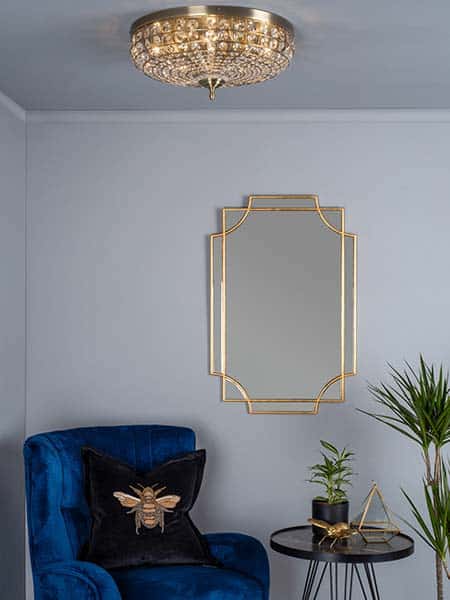
Flush lights sit directly against the ceiling, making them perfect for spaces where headroom is limited.
Why They Work:
- Space-saving: No drop from the ceiling = zero head bumping
- Even light distribution: Great for ambient lighting
- Modern designs: Stylish options now go far beyond basic glass domes
Design Insight:
Today’s flush ceiling lights are available in styles from minimalist chrome to antique brass with cut crystal. Fixtures like the Asmara flush light pictured above combine elegance with practicality, proving you don’t have to compromise on style.
Ideal for:
- Living rooms
- Bedrooms
- Hallways
- Utility spaces
Semi-Flush Lights – Elegant and Practical
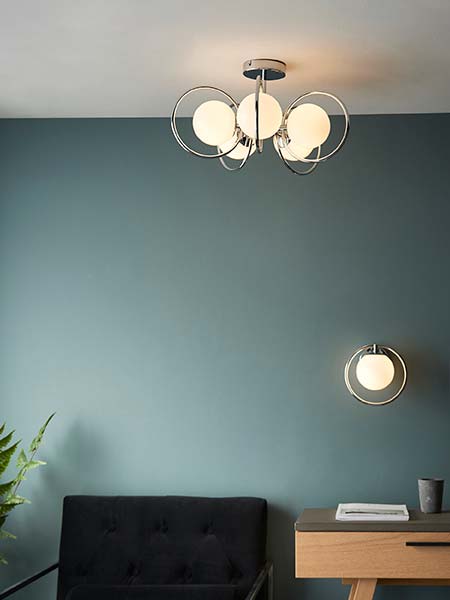
Semi-flush ceiling lights have a slight drop, typically between 10–30cm, while still sitting close to the ceiling.
Benefits:
- Slight separation from the ceiling gives depth and elegance
- Suitable for 2.2–2.4m ceilings
- Wide light spread from modern multi-bulb designs
Ideal for:
- Living rooms
- Bedrooms
- Hallways
- Living rooms
- Dining rooms
Pendant Lights? Yes, You Can Use Them (Carefully)
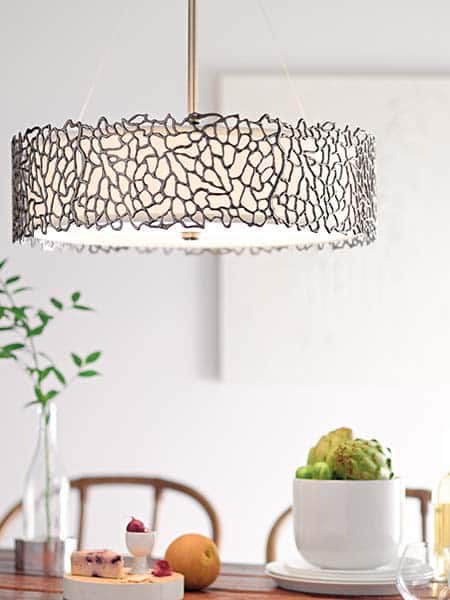
You can use pendants in low ceiling rooms, as long as they’re placed strategically.
Ideal Placement:
Over fixed furniture like:
- Dining tables
- kitchen Islands
- Beds
- Sofas
- Desks
Placing a pendant in any of these positions avoids walkways, which means you can enjoy beautiful overhead lighting without obstruction.
What to look for?
- Adjustable drop heights
- Compact, proportionate styles
- Lightweight materials
Tip: Avoid pendants with long chains or dramatic drops.
Use Wall Lights for Space Saving Ambience
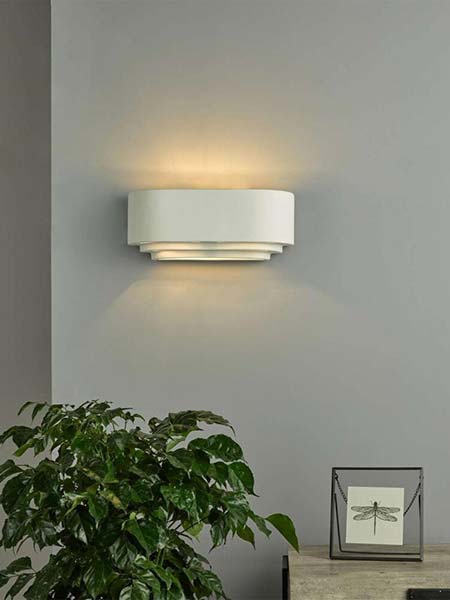
Wall lights are an excellent way to add both function and flair, especially when overhead space is tight.
Best Practice:
- Position around eye level when standing (roughly 1.5–1.7m from the floor)
- Use up lighters (like plaster wall washers) to bounce light upwards—this elongates the visual height of a room
- Pair with dimmers for a warm, inviting glow
Use Wall Lights To:
- Flank fireplaces or chimney breasts
- Add interest in hallways or beside mirrors
- Provide ambient or task lighting in bedrooms and lounges
Design Tip:
Install symmetrical wall lights behind a sofa or along a feature wall for balance and atmosphere.
Floor and Table Lamps are Versatile
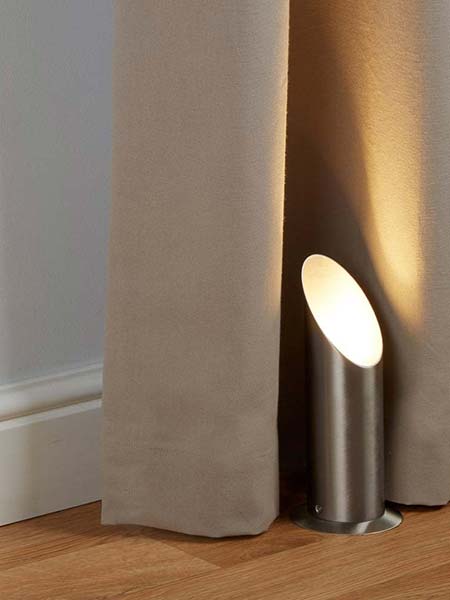
These lights aren’t just functional—they’re styling tools.
Benefits:
- Portable and super convenient
- Excellent for accent and task lighting
- Can visually “raise” the ceiling by directing light upward
Styles to Consider:
- Up lighter floor lamps (also called torchières)
- Mother-and-child lamps (with an additional reading arm)
- Slim, tall table lamps on sideboards or chests
Styling Insight:
Place matching table lamps on either side of a sofa or bed to frame the room and create depth. This technique widens the space visually and provides balanced light.
Furnishing Rooms With a Low Ceiling
We don’t profess to be expert interior designers, decorators or sell furnishings, but over the years we have learned that great lighting designs work best alongside good design principles. Here are a few basic principles.
- Use as much natural daylight as possible. Placing mirrors opposite natural light sources makes a room much brighter, and make it appear larger, too.
- Use light colours in neutral or pastel shades to brighten the room and make it appear more spacious.
- Using full length curtains can make your ceiling appear higher. Hang them from the highest point on the wall, all the way down to the floor.
- Avoid clutter or overly large or tall items of furniture. As with everything, proportion is key.
- Try and create a focal point in the room opposite the entrance door. It can be anything from a fireplace to a pair of table lamps or a coffee table. This draws the eye to the furthest point and gives an impression of space.
Frequently Asked Questions
Q) Why are flush and semi-flush lights ideal for low ceilings?
A) They’re designed to sit close to the ceiling, providing even lighting without reducing headroom. Unlike pendants or chandeliers, they don’t interrupt lines of sight or feel out of place in compact spaces.
Q) Can flush and semi-flush lights be stylish?
A) Absolutely. Modern styles range from art deco crystal designs to ultra-modern chrome or matte black finishes. Don’t sacrifice style for function, there are fixtures that offer both.
Q) Are these lights dimmable?
A) Almost all of them are! Ensure you pair with dimmable LED bulbs and a compatible dimmer switch. Always check the manufacturer’s specifications, especially if buying fixtures with integrated LEDs. We have a comprehensive guide to dimming, which can be viewed here. Some fixtures with in-built LED arrays are not dimmable, however, so please ensure the light you are purchasing is marked as dimmable.
Q) Are there alternatives to ceiling lights in low rooms?
Yes. Recessed downlights, wall lights, floor and table lamps, and even LED coving or strip lights can all be used creatively to achieve layered, flexible lighting.
Who Wrote This Article?
This guide was written by Sye Yehya – Managing Director and product specialist with over 15-years experience in domestic lighting design and application.


